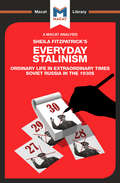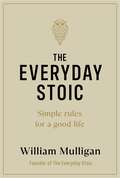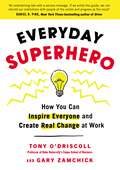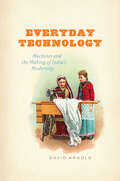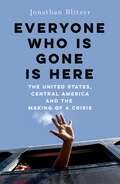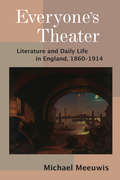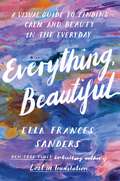- Table View
- List View
Everyday Stalinism: Ordinary Life in Extraordinary Times: Soviet Russia in the 1930s
by Sheila FitzpatrickHere is a pioneering account of everyday life under Stalin, written by a leading authority on modern Russian history. Focusing on the urban population, Fitzpatrick depicts a world of privation, overcrowding, endless lines, and broken homes, in which the regime's promises of future socialist abundance rang hollowly. We read of a government bureaucracy that often turned life into a nightmare, and of how ordinary citizens tried to circumvent it. We also read of the secret police, whose constant surveillance was endemic at this time, and the waves of terror, like the Great Purges of 1937, which periodically cast society into turmoil.
Everyday Stalinism: Ordinary Life in Extraordinary Times: Soviet Russia in the 1930s
by Sheila FitzpatrickHere is a pioneering account of everyday life under Stalin, written by a leading authority on modern Russian history. Focusing on the urban population, Fitzpatrick depicts a world of privation, overcrowding, endless lines, and broken homes, in which the regime's promises of future socialist abundance rang hollowly. We read of a government bureaucracy that often turned life into a nightmare, and of how ordinary citizens tried to circumvent it. We also read of the secret police, whose constant surveillance was endemic at this time, and the waves of terror, like the Great Purges of 1937, which periodically cast society into turmoil.
Everyday Stalinism: Ordinary Life in Extraordinary Times: Soviet Russia in the 1930s (The Macat Library)
by Victor Petrov Riley QuinnHow was the Soviet Union like a soup kitchen? In this important and highly revisionist work, historian Sheila Fitzpatrick explains that a reimagining of the Communist state as a provider of goods for the ‘deserving poor’ can be seen as a powerful metaphor for understanding Soviet life as a whole. By positioning the state both as a provider and as a relief agency, Fitzpatrick establishes it as not so much a prison (the metaphor favoured by many of her predecessors), but more the agency that made possible a way of life. Fitzpatrick’s real claim to originality, however, is to look at the relationship between the all-powerful totalitarian government and its own people from both sides – and to demonstrate that the Soviet people were not totally devoid of either agency or resources. Rather, they successfully developed practices that helped them to navigate everyday life at a time of considerable danger and multiple shortages. For many, Fitzpatrick shows, becoming an informer and reporting fellow citizens – even family and friends – to the state was a successful survival strategy. Fitzpatrick's work is noted mainly as an example of the critical thinking skill of reasoning; she marshals evidence and arguments to deliver a highly persuasive revisionist description of everyday life in Soviet time. However, her book has been criticized for the way in which it deals with possible counter-arguments, not least the charge that many of the interviewees on whose experiences she bases much of her analysis were not typical products of the Soviet system.
Everyday Stalinism: Ordinary Life in Extraordinary Times: Soviet Russia in the 1930s (The Macat Library)
by Victor Petrov Riley QuinnHow was the Soviet Union like a soup kitchen? In this important and highly revisionist work, historian Sheila Fitzpatrick explains that a reimagining of the Communist state as a provider of goods for the ‘deserving poor’ can be seen as a powerful metaphor for understanding Soviet life as a whole. By positioning the state both as a provider and as a relief agency, Fitzpatrick establishes it as not so much a prison (the metaphor favoured by many of her predecessors), but more the agency that made possible a way of life. Fitzpatrick’s real claim to originality, however, is to look at the relationship between the all-powerful totalitarian government and its own people from both sides – and to demonstrate that the Soviet people were not totally devoid of either agency or resources. Rather, they successfully developed practices that helped them to navigate everyday life at a time of considerable danger and multiple shortages. For many, Fitzpatrick shows, becoming an informer and reporting fellow citizens – even family and friends – to the state was a successful survival strategy. Fitzpatrick's work is noted mainly as an example of the critical thinking skill of reasoning; she marshals evidence and arguments to deliver a highly persuasive revisionist description of everyday life in Soviet time. However, her book has been criticized for the way in which it deals with possible counter-arguments, not least the charge that many of the interviewees on whose experiences she bases much of her analysis were not typical products of the Soviet system.
The Everyday Stoic: Simple Rules for a Good Life
by William MulliganFollow the founder of the Everyday Stoic and discover the practical wisdom of Stoicism and find contentment and happiness in your everyday life.__________Follow in the footsteps of the classical tradition of Stoicism and join a growing community of individuals seeking guidance on how to navigate the obstacles of contemporary life. From Marcus Aurelius to Seneca, the Stoics have a long and rich history.Today, William Mulligan, founder of The Everyday Stoic, transforms these principles into a practical guide for overcoming the challenges of modern life and cultivating an unshakeable sense of inner calm, so that you too can live like a stoic.Unpack the ancient wisdoms and teachings of Stoicism, such as:Confronting life's unpredictabilityNature ties us togetherThoughts create realityLittle is truly neededAll is equalWritten in a clear and accessible style, this book will reveal the universal truths of Stoicism empowering you to achieve strength and tranquillity no matter what modern life throws your way.
Everyday Stoicism: Ancient Solutions to Modern Day Problems from Marcus Aurelius and the Stoics
by Gareth SouthwellGrow in wisdom with this practical guide to Stoic philosophy for modern day-to-day lifeDiscover the path to a more contented, fulfilled life through the teachings of Stoic philosophers, from Marcus Aurelius to Epictetus. Learn how to build resilience, foster inner peace, and harness self-control.Stoic philosophy is not an armchair philosophy: it was designed by the ancient Greek and Roman philosophers to be used in day-to-day life, and their teachings offer a host of simple, practical ideas to maximise positivity in our lives.Tackling a key theme each month, from Happiness and Health to Money and Politics, Everyday Stoicism guides you through the calendar year to build a toolkit of simple exercises and practical ideas for how to live these values every day.So, harness the collective wisdom of the ancient Stoic philosophers today and discover the joy of everyday stoicism.
Everyday Superhero: How You Can Inspire Everyone And Create Real Change At Work
by Tony O'Driscoll Gary Zamchick'An entertaining tale with a serious message . . . we can rebuild our institutions with people at the centre and progress as the result!' Daniel H. Pink, bestselling author of DriveAre you struggling to create profound, lasting change in your organisation? Everyday Superhero is a simple story with a powerful solution. Meet a stressed young manager, Mae B, whose teams are being led by an authoritarian CEO. We join her on her mission to overhaul the outdated leadership systems obsessed by power, profit and process and fight for central leadership that prioritises people, purpose and principles. It's the start of a journey into a new vision of leadership, one that has been designed to take on the challenges that organisations face today. And if we follow Mae B's lead, we can all create change, when we need it most. Developed from the author's academic research at Duke University, this memorable adventure will help you create lasting change in complex and chaotic times.'This powerful book tells the story of how leaders can unlock every employee's superpower to create lasting change' Dorie Clark, bestselling author of The Long Game
Everyday Technology: Machines and the Making of India's Modernity (science.culture)
by David ArnoldIn 1909 Mohandas Karamchand Gandhi, on his way back to South Africa from London, wrote his now celebrated tract Hind Swaraj, laying out his vision for the future of India and famously rejecting the technological innovations of Western civilization. Despite his protestations, Western technology endured and helped to make India one of the leading economies in our globalized world. Few would question the dominant role that technology plays in modern life, but to fully understand how India first advanced into technological modernity, argues David Arnold, we must consider the technology of the everyday. Everyday Technology is a pioneering account of how small machines and consumer goods that originated in Europe and North America became objects of everyday use in India in the late nineteenth and early twentieth centuries. Rather than investigate “big” technologies such as railways and irrigation projects, Arnold examines the assimilation and appropriation of bicycles, rice mills, sewing machines, and typewriters in India, and follows their impact on the ways in which people worked and traveled, the clothes they wore, and the kind of food they ate. But the effects of these machines were not limited to the daily rituals of Indian society, and Arnold demonstrates how such small-scale technologies became integral to new ways of thinking about class, race, and gender, as well as about the politics of colonial rule and Indian nationhood. Arnold’s fascinating book offers new perspectives on the globalization of modern technologies and shows us that to truly understand what modernity became, we need to look at the everyday experiences of people in all walks of life, taking stock of how they repurposed small technologies to reinvent their world and themselves.
Everyday Technology: Machines and the Making of India's Modernity (science.culture)
by David ArnoldIn 1909 Mohandas Karamchand Gandhi, on his way back to South Africa from London, wrote his now celebrated tract Hind Swaraj, laying out his vision for the future of India and famously rejecting the technological innovations of Western civilization. Despite his protestations, Western technology endured and helped to make India one of the leading economies in our globalized world. Few would question the dominant role that technology plays in modern life, but to fully understand how India first advanced into technological modernity, argues David Arnold, we must consider the technology of the everyday. Everyday Technology is a pioneering account of how small machines and consumer goods that originated in Europe and North America became objects of everyday use in India in the late nineteenth and early twentieth centuries. Rather than investigate “big” technologies such as railways and irrigation projects, Arnold examines the assimilation and appropriation of bicycles, rice mills, sewing machines, and typewriters in India, and follows their impact on the ways in which people worked and traveled, the clothes they wore, and the kind of food they ate. But the effects of these machines were not limited to the daily rituals of Indian society, and Arnold demonstrates how such small-scale technologies became integral to new ways of thinking about class, race, and gender, as well as about the politics of colonial rule and Indian nationhood. Arnold’s fascinating book offers new perspectives on the globalization of modern technologies and shows us that to truly understand what modernity became, we need to look at the everyday experiences of people in all walks of life, taking stock of how they repurposed small technologies to reinvent their world and themselves.
Everyday Technology: Machines and the Making of India's Modernity (science.culture)
by David ArnoldIn 1909 Mohandas Karamchand Gandhi, on his way back to South Africa from London, wrote his now celebrated tract Hind Swaraj, laying out his vision for the future of India and famously rejecting the technological innovations of Western civilization. Despite his protestations, Western technology endured and helped to make India one of the leading economies in our globalized world. Few would question the dominant role that technology plays in modern life, but to fully understand how India first advanced into technological modernity, argues David Arnold, we must consider the technology of the everyday. Everyday Technology is a pioneering account of how small machines and consumer goods that originated in Europe and North America became objects of everyday use in India in the late nineteenth and early twentieth centuries. Rather than investigate “big” technologies such as railways and irrigation projects, Arnold examines the assimilation and appropriation of bicycles, rice mills, sewing machines, and typewriters in India, and follows their impact on the ways in which people worked and traveled, the clothes they wore, and the kind of food they ate. But the effects of these machines were not limited to the daily rituals of Indian society, and Arnold demonstrates how such small-scale technologies became integral to new ways of thinking about class, race, and gender, as well as about the politics of colonial rule and Indian nationhood. Arnold’s fascinating book offers new perspectives on the globalization of modern technologies and shows us that to truly understand what modernity became, we need to look at the everyday experiences of people in all walks of life, taking stock of how they repurposed small technologies to reinvent their world and themselves.
Everyday Technology: Machines and the Making of India's Modernity (science.culture)
by David ArnoldIn 1909 Mohandas Karamchand Gandhi, on his way back to South Africa from London, wrote his now celebrated tract Hind Swaraj, laying out his vision for the future of India and famously rejecting the technological innovations of Western civilization. Despite his protestations, Western technology endured and helped to make India one of the leading economies in our globalized world. Few would question the dominant role that technology plays in modern life, but to fully understand how India first advanced into technological modernity, argues David Arnold, we must consider the technology of the everyday. Everyday Technology is a pioneering account of how small machines and consumer goods that originated in Europe and North America became objects of everyday use in India in the late nineteenth and early twentieth centuries. Rather than investigate “big” technologies such as railways and irrigation projects, Arnold examines the assimilation and appropriation of bicycles, rice mills, sewing machines, and typewriters in India, and follows their impact on the ways in which people worked and traveled, the clothes they wore, and the kind of food they ate. But the effects of these machines were not limited to the daily rituals of Indian society, and Arnold demonstrates how such small-scale technologies became integral to new ways of thinking about class, race, and gender, as well as about the politics of colonial rule and Indian nationhood. Arnold’s fascinating book offers new perspectives on the globalization of modern technologies and shows us that to truly understand what modernity became, we need to look at the everyday experiences of people in all walks of life, taking stock of how they repurposed small technologies to reinvent their world and themselves.
Everyday Technology: Machines and the Making of India's Modernity (science.culture)
by David ArnoldIn 1909 Mohandas Karamchand Gandhi, on his way back to South Africa from London, wrote his now celebrated tract Hind Swaraj, laying out his vision for the future of India and famously rejecting the technological innovations of Western civilization. Despite his protestations, Western technology endured and helped to make India one of the leading economies in our globalized world. Few would question the dominant role that technology plays in modern life, but to fully understand how India first advanced into technological modernity, argues David Arnold, we must consider the technology of the everyday. Everyday Technology is a pioneering account of how small machines and consumer goods that originated in Europe and North America became objects of everyday use in India in the late nineteenth and early twentieth centuries. Rather than investigate “big” technologies such as railways and irrigation projects, Arnold examines the assimilation and appropriation of bicycles, rice mills, sewing machines, and typewriters in India, and follows their impact on the ways in which people worked and traveled, the clothes they wore, and the kind of food they ate. But the effects of these machines were not limited to the daily rituals of Indian society, and Arnold demonstrates how such small-scale technologies became integral to new ways of thinking about class, race, and gender, as well as about the politics of colonial rule and Indian nationhood. Arnold’s fascinating book offers new perspectives on the globalization of modern technologies and shows us that to truly understand what modernity became, we need to look at the everyday experiences of people in all walks of life, taking stock of how they repurposed small technologies to reinvent their world and themselves.
Everyday Technology: Machines and the Making of India's Modernity (science.culture)
by David ArnoldIn 1909 Mohandas Karamchand Gandhi, on his way back to South Africa from London, wrote his now celebrated tract Hind Swaraj, laying out his vision for the future of India and famously rejecting the technological innovations of Western civilization. Despite his protestations, Western technology endured and helped to make India one of the leading economies in our globalized world. Few would question the dominant role that technology plays in modern life, but to fully understand how India first advanced into technological modernity, argues David Arnold, we must consider the technology of the everyday. Everyday Technology is a pioneering account of how small machines and consumer goods that originated in Europe and North America became objects of everyday use in India in the late nineteenth and early twentieth centuries. Rather than investigate “big” technologies such as railways and irrigation projects, Arnold examines the assimilation and appropriation of bicycles, rice mills, sewing machines, and typewriters in India, and follows their impact on the ways in which people worked and traveled, the clothes they wore, and the kind of food they ate. But the effects of these machines were not limited to the daily rituals of Indian society, and Arnold demonstrates how such small-scale technologies became integral to new ways of thinking about class, race, and gender, as well as about the politics of colonial rule and Indian nationhood. Arnold’s fascinating book offers new perspectives on the globalization of modern technologies and shows us that to truly understand what modernity became, we need to look at the everyday experiences of people in all walks of life, taking stock of how they repurposed small technologies to reinvent their world and themselves.
Everyday Violence in Britain, 1850-1950: Gender and Class (Women And Men In History)
by Ivor Crewe Shani D'CruzeThe diverse violence of modern Britain is hardly new. The Britain of 1850 to 1950 was similarly afflicted. The book is divided into four parts. 'Getting Hurt' which looks at everyday violence in the home (including a chapter on infanticide). 'Uses and Rejections' two chapters on the use of violence within groups of men and women outside the home (for example, violence within youth gangs, and male violence centred around pubs). 'Going Public' three chapters on how violence was regulated by law and the professional agencies which were set up to deal with it. 'Perceptions and Representations' this final section looks at how violence was written about, using both fiction and non-fiction sources. Throughout the book the recurring themes of gender, class, continuity and change, public/private, and experience, discourses and representations are highlighted.
Everyday Violence in Britain, 1850-1950: Gender and Class (Women And Men In History)
by Ivor Crewe Shani D'CruzeThe diverse violence of modern Britain is hardly new. The Britain of 1850 to 1950 was similarly afflicted. The book is divided into four parts. 'Getting Hurt' which looks at everyday violence in the home (including a chapter on infanticide). 'Uses and Rejections' two chapters on the use of violence within groups of men and women outside the home (for example, violence within youth gangs, and male violence centred around pubs). 'Going Public' three chapters on how violence was regulated by law and the professional agencies which were set up to deal with it. 'Perceptions and Representations' this final section looks at how violence was written about, using both fiction and non-fiction sources. Throughout the book the recurring themes of gender, class, continuity and change, public/private, and experience, discourses and representations are highlighted.
Everyday Zionism in East-Central Europe: Nation-Building in War and Revolution, 1914-1920
by Jan RybakEveryday Zionism examines Zionist activism in East-Central Europe during the years of war, occupation, revolution, the collapse of empires, and the formation of nation states in the years 1914 to 1920. Against the backdrop of the Great War—its brutal aftermath and consequent violence—the day-to-day encounters between Zionist activists and the Jewish communities in the region gave the movement credibility, allowed it to win support and to establish itself as a leading force in Jewish political and social life for decades to come. Through activists' efforts, Zionism came to mean something new: Rather than being concerned with debates over Jewish nationhood and pioneering efforts in Palestine, it came to be about aiding starving populations, organizing soup-kitchens, establishing orphanages, schools, kindergartens, and hospitals, negotiating with the authorities, and leading self-defence against pogroms. Through this engagement Zionism evolved into a mass movement that attracted and inspired tens of thousands of Jews throughout the region. Everyday Zionism approaches the major European events of the period from the dual perspectives of Jewish communities and the Zionist activists on the ground, demonstrating how war, revolution, empire, and nation held very different meanings for people, depending on their local circumstances. Based on extensive archival research, the study shows how during the war and its aftermath East-Central Europe saw a large-scale nation-building project by Zionist activists who fought for and led their communities to shape for them a national future.
Everyday Zionism in East-Central Europe: Nation-Building in War and Revolution, 1914-1920
by Jan RybakEveryday Zionism examines Zionist activism in East-Central Europe during the years of war, occupation, revolution, the collapse of empires, and the formation of nation states in the years 1914 to 1920. Against the backdrop of the Great War—its brutal aftermath and consequent violence—the day-to-day encounters between Zionist activists and the Jewish communities in the region gave the movement credibility, allowed it to win support and to establish itself as a leading force in Jewish political and social life for decades to come. Through activists' efforts, Zionism came to mean something new: Rather than being concerned with debates over Jewish nationhood and pioneering efforts in Palestine, it came to be about aiding starving populations, organizing soup-kitchens, establishing orphanages, schools, kindergartens, and hospitals, negotiating with the authorities, and leading self-defence against pogroms. Through this engagement Zionism evolved into a mass movement that attracted and inspired tens of thousands of Jews throughout the region. Everyday Zionism approaches the major European events of the period from the dual perspectives of Jewish communities and the Zionist activists on the ground, demonstrating how war, revolution, empire, and nation held very different meanings for people, depending on their local circumstances. Based on extensive archival research, the study shows how during the war and its aftermath East-Central Europe saw a large-scale nation-building project by Zionist activists who fought for and led their communities to shape for them a national future.
Everyone against Us: Public Defenders and the Making of American Justice (Chicago Visions and Revisions)
by Allen GoodmanA former public defender testifies to the vivid human suffering at the heart of America’s criminal justice system. As a public defender, Allen Goodman faced cross-examination from family and friends every day: How could he work to help criminals? How could he live with himself? Presumed guilty by association, Goodman quickly learned that people didn’t really want an answer; they wanted a justification, perhaps even an apology. Ever the idealist, Goodman answered anyway: Everyone deserves justice. Everyone against Us is Goodman’s testimony of his life as a public defender. In it, he documents his efforts to defend clients, both guilty and innocent, against routine police abuse, prosecutorial misconduct, and unjust sentencing. To work in criminal justice, Goodman shows, is to confront and combat vivid human suffering, of both victims and perpetrators. From sex trafficking, murder, and abuse to false conviction, torture, and systemic racism, Goodman describes the daily experiences that both rattled his worldview and motivated him to work ever harder. Part memoir, part exposé, Everyone against Us is the moving story of an embattled civil servant who staves off the worst abuses of the criminal justice system, at great personal cost.
Everyone against Us: Public Defenders and the Making of American Justice (Chicago Visions and Revisions)
by Allen GoodmanA former public defender testifies to the vivid human suffering at the heart of America’s criminal justice system. As a public defender, Allen Goodman faced cross-examination from family and friends every day: How could he work to help criminals? How could he live with himself? Presumed guilty by association, Goodman quickly learned that people didn’t really want an answer; they wanted a justification, perhaps even an apology. Ever the idealist, Goodman answered anyway: Everyone deserves justice. Everyone against Us is Goodman’s testimony of his life as a public defender. In it, he documents his efforts to defend clients, both guilty and innocent, against routine police abuse, prosecutorial misconduct, and unjust sentencing. To work in criminal justice, Goodman shows, is to confront and combat vivid human suffering, of both victims and perpetrators. From sex trafficking, murder, and abuse to false conviction, torture, and systemic racism, Goodman describes the daily experiences that both rattled his worldview and motivated him to work ever harder. Part memoir, part exposé, Everyone against Us is the moving story of an embattled civil servant who staves off the worst abuses of the criminal justice system, at great personal cost.
Everyone Counts: Could "Participatory Budgeting" Change Democracy? (Brown Democracy Medal)
by Josh LernerThe Laurence and Lynne Brown Democracy Medal recognizes outstanding individuals, groups, and organizations that produce exceptional innovations to further democracy in the United States or around the world. The inaugural medal winner, the Participatory Budgeting Project (PBP), is an innovative not-for-profit organization that promotes "participatory budgeting," an inclusive process that empowers community members to make informed decisions about public spending. More than 46,000 people in communities across the United States have decided how to spend $45 million through programs that PBP helped spark over the last five years. In Everyone Counts, PBP co-founder and executive director Josh Lerner provides a concise history of the organization’s origins and its vision, highlighting its real-world successes in fostering grassroots budgeting campaigns in such cities as New York, Boston, and Chicago. As more and more communities turn to participatory budgeting as a means of engaging citizens, prioritizing civic projects, and allocating local, state, and federal funding, this cogent volume will offer guidance and inspiration to others who want to transform democracy in the United States and elsewhere. "The Participatory Budgeting Project exemplifies the essential features the award committee was looking for in its inaugural recipient. Political and economic inequality is part of the American national discussion, and participatory budgeting helps empower marginalized groups that do not normally take part in a process that is so critical for democratic life."— John Gastil, Director of the McCourtney Institute for Democracy
Everyone Knows Your Mother is a Witch
by Rivka GalchenThe plague is spreading. The hundred year war is beginning. Katharina Kepler is believed to be a witch. The startling, witty, highly anticipated second novel from the critically acclaimed author of Atmospheric Disturbances.
Everyone Who Is Gone Is Here: The United States, Central America, and the Making of a Crisis
by Jonathan Blitzer'Urgent, extraordinary . . . a tribute to the astonishing indomitability of the human spirit.' - Patrick Radden Keefe, bestselling author Empire of Pain'Moving, sweeping, and masterful' - Sally Hayden, author of My Fourth Time, We DrownedNew Yorker journalist Jonathan Blitzer has been covering the immigration crisis at America’s southern border for nearly a decade, but the current emergency is the end of a much larger story. In this, his first book, Blitzer goes back to the beginning: to the shadowy civil wars in El Salvador and Guatemala in the 1980s; to the American prison system in the 1990s and the policies of mass deportation that transformed local street criminals into international crime syndicates; to Honduras’s brutal crackdown on crime in the 2000s and the emergence of gangs across Central America and the United States. And then the Trump era, in which immigration became a vector of resurgent populism, with mass internments the order of the day.Everyone Who Is Gone Is Here is a fresh and full account of America’s immigration problems, but it is much more than that. It is an odyssey of struggle and resilience, telling the epic story of people whose lives ebb and flow across the border and those who help and hinder them. It is a gripping and persuasive attempt to answer not only the question of how America got there, but the vital question of who we are and who we want to be in our liberal Western democracies, whether we are incarcerating children on our southern borders or watching them drown on the shores of the Mediterranean.'What an incredibly thorough documentation of the causes of the immigration crisis, the discussions that have been going on through multiple administrations.' - Jon Stewart, The Daily Show
Everyone’s Theater: Literature and Daily Life in England, 1860–1914
by Michael MeeuwisNearly all residents of England and its colonies between 1860 and 1914 were active theatergoers, and many participated in the amateur theatricals that defined late Victorian life. The Victorian theater was not an abstract figuration of the world as a stage, but a media system enmeshed in mass lived experience that fulfilled in actuality the concept of a theatergoing nation. Everyone’s Theater turns to local history, the words of everyday Victorians found in their diaries and production records, to recover this lost chapter of theater history in which amateur drama domesticates the stage. Professional actors and playwrights struggled to make their productions compatible with ideas and techniques that could be safely reproduced in the home—and in amateur performances from Canada to India. This became the first true English national theater: a society whose myriad classes found common ground in theatrical display. Everyone’s Theater provides new ways to extend Victorian literature into the dimension of voice, sound, and embodiment, and to appreciate the pleasures of Victorian theatricality.
Everything, Beautiful: A Visual Guide to Finding Calm and Beauty in the Everyday
by Ella Frances SandersFrom the New York Times bestselling author of Lost in Translation comes an illustrated manifesto and an interactive guide to reclaiming the wonder of the everyday through mindful activities, creative exercises and heart-warming stories.In a world that sometimes moves too fast, Ella Frances Sanders is on a mission to remind us all to slow down and find beauty in the ordinary as a balm for the soul. Part meditation, part self-help guide and part interactive journal, Everything, Beautiful invites us to rethink what 'beauty' can be, why it matters and how we can find it all around us if we just stop to look. It is a reminder that each day all of us are surrounded by beauty that can't be bought: spiderwebs only seen in the sunlight, the greenish glow of a fox's eyes watching in the dark, or the comforting screech of the train that takes you to your many futures.Filled with thoughtful, intimate and brilliant insights, inspirational quotes, breathtaking illustrations and space for readers of all ages to write, draw and reflect on their own ideas of beauty, Everything, Beautiful is the perfect book for everyone who wants to reclaim a sense of wonder in their everyday lives.
Everything for Everyone: The Radical Tradition That Is Shaping the Next Economy
by Nathan SchneiderThe origins of the next radical economy is rooted in a tradition that has empowered people for centuries and is now making a comeback. A new feudalism is on the rise. While monopolistic corporations feed their spoils to the rich, more and more of us are expected to live gig to gig. But, as Nathan Schneider shows, an alternative to the robber-baron economy is hiding in plain sight; we just need to know where to look. Cooperatives are jointly owned, democratically controlled enterprises that advance the economic, social, and cultural interests of their members. They often emerge during moments of crisis not unlike our own, putting people in charge of the workplaces, credit unions, grocery stores, healthcare, and utilities they depend on.Everything for Everyone chronicles this revolution -- from taxi cooperatives keeping Uber at bay, to an outspoken mayor transforming his city in the Deep South, to a fugitive building a fairer version of Bitcoin, to the rural electric co-op members who are propelling an aging system into the future. As these pioneers show, co-ops are helping us rediscover our capacity for creative, powerful, and fair democracy.

